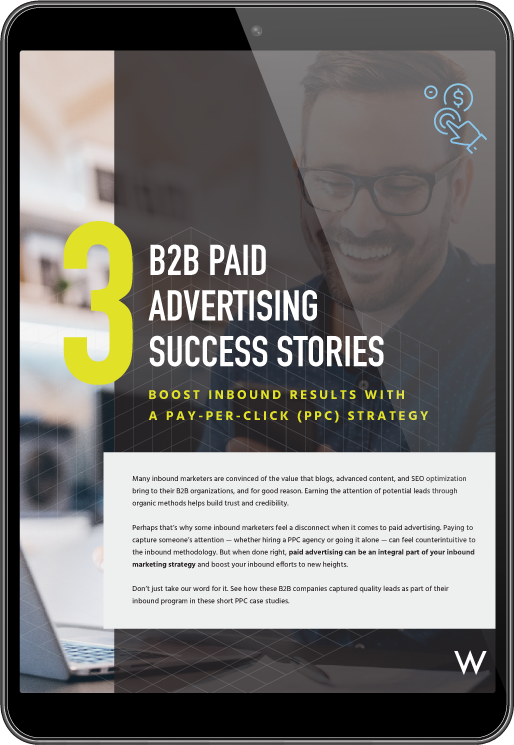When and how paid ads can support your B2B inbound program.

You’ve committed to your B2B inbound program and aligned marketing, sales, and customer service teams to attract, convert, and delight prospects and customers. You’ve implemented a helpful, SEO-driven content strategy that answers your buyer personas’ needs, based on real data.
So, after committing to inbound, why would you add a “push” method like pay-per-click ads (PPC) to your mix? When can organic search engine optimization (SEO) efforts benefit from a paid ads program? And how can you create a strategic PPC plan that boosts your inbound performance without blowing your marketing budget?
While organic SEO is the best long-term technique for attracting sustained, high-quality traffic to your B2B website — and for nurturing traffic into qualified leads that convert to sales — tactical use of paid advertising has its place in some inbound marketing plans.
This guide breaks it down, answers the big questions about what’s involved, and can help you decide if PPC is right for your inbound marketing strategy.
What is Paid Media?
Digital ads, including pay-per-click ads, are an outbound marketing tactic. This can include (but is not limited to):
- Search engine ads
- Display ads on industry websites
- Social media ads
In specific use cases, paid ads can be just the right precision instrument to accelerate your inbound results and complement your content efforts with remarkable speed and accuracy. But that doesn’t mean it’s the right tool for every business or every marketing strategy.
What does pay-per-click have to do with inbound?
At first glance, paid digital advertising and inbound marketing appear to be polar opposites.
But a closer look reveals that PPC serves as another tool in your marketing arsenal to help prospects find you during an internet search.
So, while it’s an outbound effort, in the right hands, it can have an inbound impact.
Your overall goal is to leverage these two as complementary forces.
Just as you create inbound marketing content to meet the needs of your buyers — and to be found based on their keyword searches — your paid search tactics add an opportunity to meet prospects based on their search criteria, and to lead them directly to your content that supplies helpful answers to their search queries.
That’s right. Pay-per-click can make you more helpful. Since inbound is all about getting the right information to the right people at the right moment, it makes perfect sense to use paid search to help serve up your content to your target audience at the moment they come looking for help.
In turn, the value of your marketing content drives the impact of your PPC ads. This self-reinforcing feedback loop can actually strengthen and accelerate your SEO performance both rapidly and steadily over time.
And the data you gain from analysis and reporting can help you refine and manage both sides of the equation — organic and paid — for continuous improvement.
A well-researched, disciplined, holistic approach to inbound marketing can successfully leverage a paid ads strategy — and when done well, PPC and inbound content strengthen each other.
Major considerations include:
If you’re working with an agency to manage your paid media program, you likely had a conversation in which you set expectations for results alongside your monthly budget.
You should expect your PPC specialist to clarify what gets measured, how to use the analysis and reporting for communicating with others in your organization, and how your team can incorporate analysis and reporting into continuous improvement — for both your paid ads and your inbound content.
Developing and executing a PPC program can be… well, a lot.
But in able hands, a paid ad program can also DO a lot, in short order.

You recognize potential opportunities to use PPC to boost your inbound marketing, and you’ve calculated the value of agency-managed paid media over the steep (and potentially pricey) learning curves of DIY pay-per-click.
Great — so now what? How do you decide which agency is the right fit for your B2B marketing needs, your inbound methodology, and your budget?
Step 1: Eliminate PPC agencies that don’t support your inbound strategy.
If all they do is pay-per-click or outbound advertising, it’s tough to trust that you’d end up with a PPC program that’s well-researched to not just give you a short-term boost, but also deepen and grow your SEO and inbound performance.
Step 2: Review and compare the agencies that remain. Consider these questions:
It can take time and effort to find the right fit, but it’s also essential for getting the most out of a specialized combination of inbound marketing plus pay-per-click ads. Ultimately, your PPC budget is more than a quick shot in the arm for your website traffic. It’s an investment in your long-term, organic SEO growth that complements and supports all your marketing content.
And when you and your agency are on the same page, the results speak for themselves.
We know search. When you’re looking for more information, it can be easy to disappear down an internet rabbit hole. Instead, you can find all our blog posts on paid media here, in easy-access, digestible articles with a clear focus on B2B industrial companies.

Just fill out the form to download your copy of The Inbound Marketer’s Guide to Paid Media.
Print it, share it, or use it to create your own PPC to-do list!